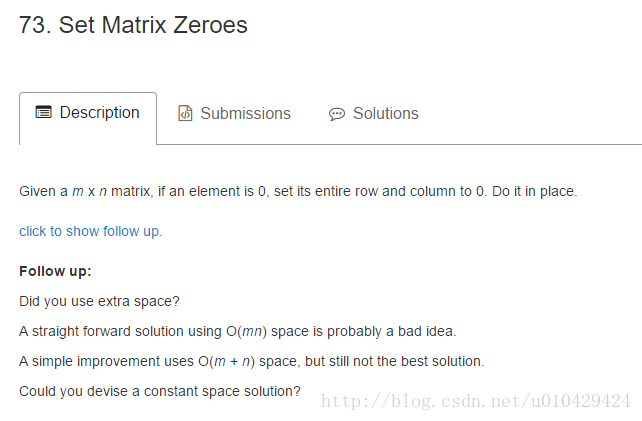题目大意:
给出一个m * n的矩阵,如果矩阵中的某个元素为0,则将该元素所在的整行和整列设为0,要求空间复杂度为O(1),举个栗子:
[0,1,2,3] [0,0,0,0]
[4,5,6,7] -> [0,5,6,7]
[8,9,1,2] [0,9,1,2]
思路:
如果放宽对空间复杂度的限制,可以将原始矩阵复制一份,一边遍历原始矩阵,一边修改复制矩阵,这样的空间复杂度为O(mn)。
再优化一下,开辟一个大小为m的列表和一段大小为n的列表,m是矩阵的行数, n是矩阵的列数。如果(i,j)位置为0,将 i 保存到大小为m的列表中(m列表),将 j 保存到大小为n的列表中(n列表)。这样,相当于添加了标志位,m列表中标志哪一行要整行变为0,n列表中标志哪一列要整列变为0。这种方法的空间复杂度为O(m+n)。
当然,还可以再优化一下,不必额外开辟m + n的空间,充分利用矩阵的空间,将第一列和第一行作为m列表和n列表。
Python代码如下:
class Solution(object):
def setZeroes(self, matrix):
"""
:type matrix: List[List[int]]
:rtype: void Do not return anything, modify matrix in-place instead.
"""
first_row = False
first_col = False
rows = len(matrix)
cols = len(matrix[0])
# 遍历第一行
for i in range(cols):
if matrix[0][i] == 0:
first_row = True
break
# 遍历第一列
for i in range(rows):
if matrix[i][0] == 0:
first_col = True
break
for i in range(1, rows):
for j in range(1, cols):
if matrix[i][j] == 0:
matrix[i][0] = 0
matrix[0][j] = 0
for i in range(1, rows):
for j in range(1, cols):
if matrix[i][0] == 0 or matrix[0][j] == 0:
matrix[i][j] = 0
if first_row:
for i in range(cols):
matrix[0][i] = 0
if first_col:
for i in range(rows):
matrix[i][0] = 0
# matrix = [
# [0,2,3,4],
# [5,6,7,0],
# [9,10,11,12]
# ]
# matrix= [
# [0,1,1,5],
# [4,3,1,4],
# [0,1,1,4],
# [1,2,1,3],
# [0,1,1,1]
# ]
# matrix = [
# [1],
# [0]
# ]
matrix = [
[-4, -21, 6, -7, 0],
[-8, 6, -8, -6, 0],
[21, 2, -9, -6,-10]
]
Solution().setZeroes(matrix)
# print()
for i in range(len(matrix)):
for j in range(len(matrix[0])):
print(matrix[i][j],' ', end = '')
print()




























 768
768

 被折叠的 条评论
为什么被折叠?
被折叠的 条评论
为什么被折叠?








